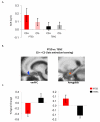Neurobiological basis of failure to recall extinction memory in posttraumatic stress disorder
- PMID: 19748076
- PMCID: PMC2787650
- DOI: 10.1016/j.biopsych.2009.06.026
Neurobiological basis of failure to recall extinction memory in posttraumatic stress disorder
Abstract
Background: A clinical characteristic of posttraumatic stress disorder (PTSD) is persistently elevated fear responses to stimuli associated with the traumatic event. The objective herein is to determine whether extinction of fear responses is impaired in PTSD and whether such impairment is related to dysfunctional activation of brain regions known to be involved in fear extinction, viz., amygdala, hippocampus, ventromedial prefrontal cortex (vmPFC), and dorsal anterior cingulate cortex (dACC).
Methods: Sixteen individuals diagnosed with PTSD and 15 trauma-exposed non-PTSD control subjects underwent a 2-day fear conditioning and extinction protocol in a 3-T functional magnetic resonance imaging scanner. Conditioning and extinction training were conducted on day 1. Extinction recall (or extinction memory) test was conducted on day 2 (extinguished conditioned stimuli presented in the absence of shock). Skin conductance response (SCR) was scored throughout the experiment as an index of the conditioned response.
Results: The SCR data revealed no significant differences between groups during acquisition and extinction of conditioned fear on day 1. On day 2, however, PTSD subjects showed impaired recall of extinction memory. Analysis of functional magnetic resonance imaging data showed greater amygdala activation in the PTSD group during day 1 extinction learning. During extinction recall, lesser activation in hippocampus and vmPFC and greater activation in dACC were observed in the PTSD group. The magnitude of extinction memory across all subjects was correlated with activation of hippocampus and vmPFC during extinction recall testing.
Conclusions: These findings support the hypothesis that fear extinction is impaired in PTSD. They further suggest that dysfunctional activation in brain structures that mediate fear extinction learning, and especially its recall, underlie this impairment.
Figures




Comment in
-
Imbalance of approach and avoidance: the yin and yang of anxiety disorders.Biol Psychiatry. 2009 Dec 15;66(12):1072-4. doi: 10.1016/j.biopsych.2009.09.023. Biol Psychiatry. 2009. PMID: 19944792 Free PMC article. No abstract available.
References
-
- Liberzon I, Sripada CS. The functional neuroanatomy of PTSD: a critical review. Prog Brain Res. 2008;167:151–169. - PubMed
-
- Rauch SL, Shin LM, Phelps EA. Neurocircuitry models of posttraumatic stress disorder and extinction: human neuroimaging research--past, present, and future. Biol Psychiatry. 2006;60:376–382. - PubMed
-
- Milad MR, Rauch SL. The role of the orbitofrontal cortex in anxiety disorders. Ann N Y Acad Sci. 2007;1121:546–561. - PubMed
-
- Shin LM, Orr SP, Carson MA, Rauch SL, Macklin ML, Lasko NB, et al. Regional cerebral blood flow in the amygdala and medial prefrontal cortex during traumatic imagery in male and female Vietnam veterans with PTSD. Arch Gen Psychiatry. 2004;61:168–176. - PubMed
Publication types
MeSH terms
Substances
Grants and funding
LinkOut - more resources
Full Text Sources
Other Literature Sources
Medical

